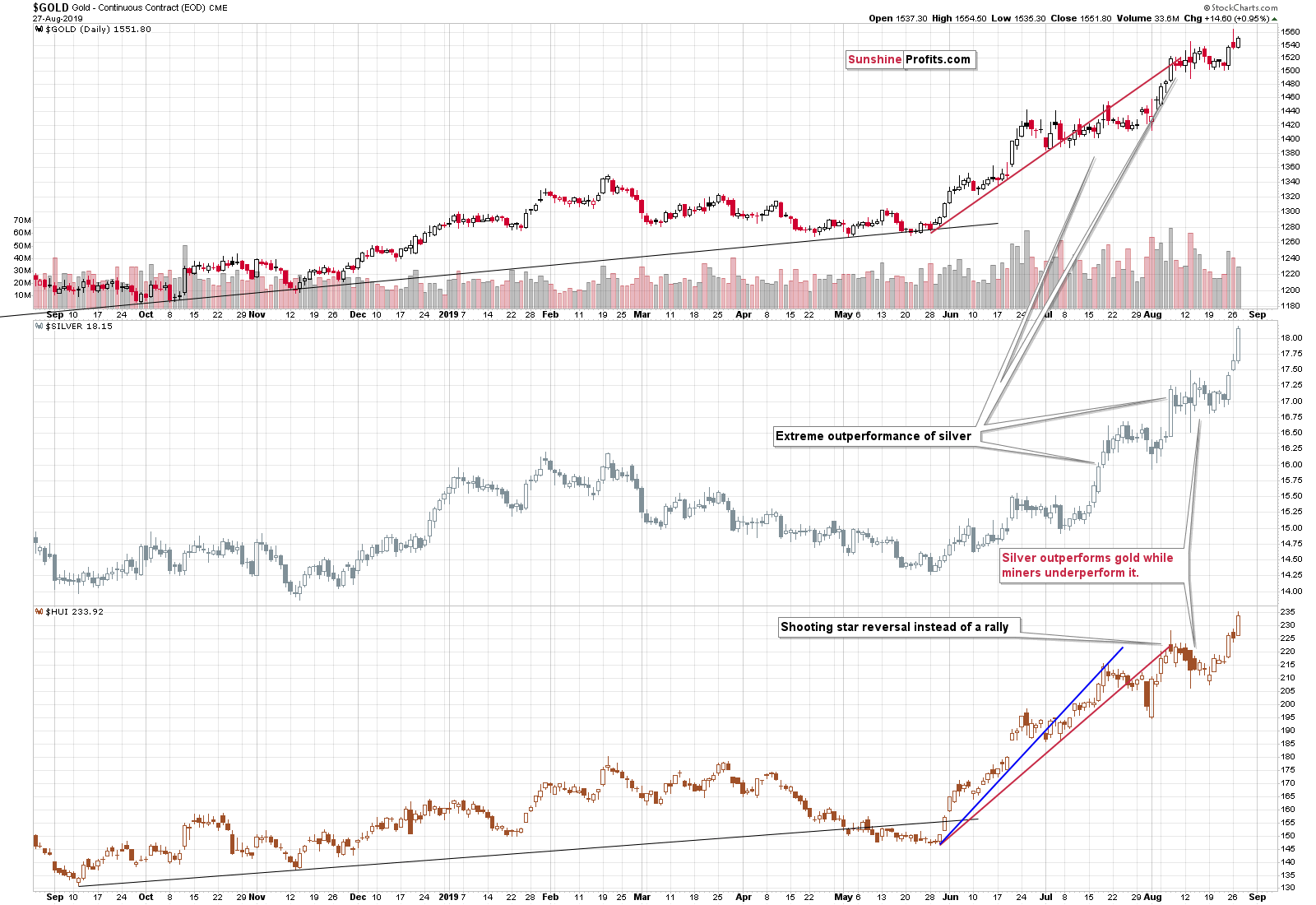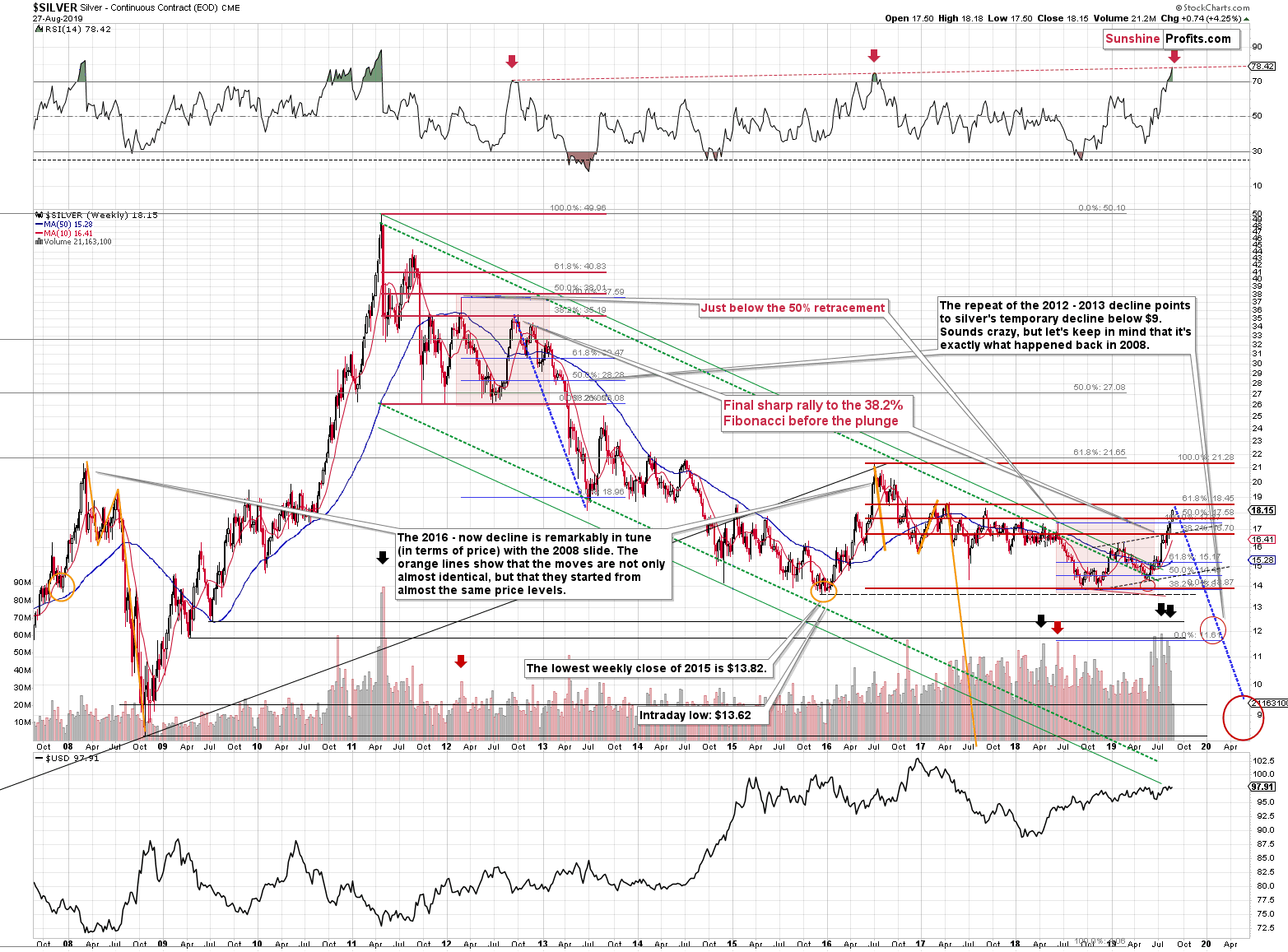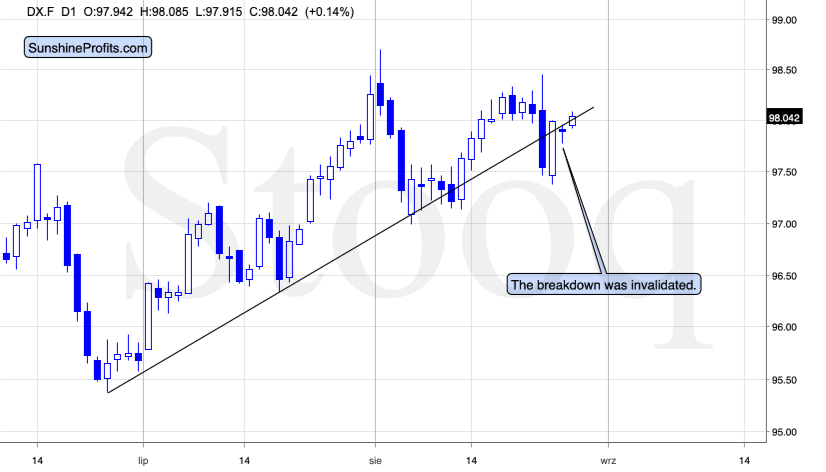Briefly: in our opinion, full (250% of the regular size of the position) speculative short position in gold, silver, and mining stocks are justified from the risk/reward point of view at the moment of publishing this Alert.
Silver soared yesterday and it moved higher also in today's pre-market trading. Some will say that the silver rocket is going to shoot straight to the moon, pass it and reach the stars, defying most laws of physics. But is this really the most likely scenario? After all, silver outperformed gold at the tops so many times, and "this time is different" are very costly words in the investment world. Has silver soared too high, just like Icarus, whose wings melted from sun's heat, and who then plunged into the sea? What changed in silver, and what does it imply?
Silver's Short-Term Outperformance
Just as what we wrote in the previous paragraph, silver outperformed gold to a huge extent and this continues also today.
The first question should be what has changed, but let's recall the list of the key factors that are currently in play:
Critical factors:
- The USD Index broke above the very long-term resistance line and verified the breakout above it. Its huge upswing is already underway.
- The USD's long-term upswing is an extremely important and bearish factor for gold. There were only two similar cases in the past few decades, when USD Index was starting profound, long-term bull markets, and they were both accompanied by huge declines in gold and the rest of the precious metals market
- Out of these two similar cases, only one is very similar - the case when gold topped in February 1996. The similarity extends beyond gold's about a yearly delay in reaction to the USD's rally. Also the shape of gold price moves prior to the 1996 high and what we saw in the last couple of years is very similar, which confirm the analysis of the gold-USD link and the above-mentioned implications of USD Index's long-term breakout.
- The similarity between now and 1996 extends to silver and mining stocks - in other words, it goes beyond USD, gold-USD link, and gold itself. The white metal and its miners appear to be in a similar position as well, and the implications are particularly bearish for the miners. After their 1996 top, they erased more than 2/3rds of their prices.
[The above is actually one point where something might have potentially changed, so we will investigate it shortly]
- Many investors got excited by the gold-is-soaring theme in the last few months, but looking beyond the short-term moves, reveals that most of the precious metals sector didn't show substantial strength that would be really visible from the long-term perspective. Gold doesn't appear to be starting a new bull market here, but rather to be an exception from the rule.
Very important, but not as critical factors:
- Long-term technical signs for silver, i.a. the analogy in terms of price to what we saw in 2008, shows that silver could slide even below $10.
[Silver is not even close to its 2016 high, so the above point remains definitely up-to-date]
- Silver's very long-term cycles point to a major reversal taking place right now and since the most recent move was up, the implications are bearish (this is also silver's technical sign, but it's so important that it deserves its own point)
[The recent upswing in silver doesn't change anything regarding the cycle - long-term cycles don't have to work on an exact basis, but rather on a near-to basis, so the cycle continues to support a major reversal in the silver price]
- Long-term technical signs for gold stocks point to this not being a new gold bull market beginning. Among others, it's their long-term underperformance relative to gold that hint this is rather a corrective upswing within a bear market that is not over yet.
- Record-breaking weekly volume in gold is a strong sign pointing to lower gold prices
Important factors:
- Extreme volume reading in the SIL ETF (proxy for silver stocks) is an effective indication that lower values of silver miners are to be expected
- Silver's short-term outperformance of gold, and gold stocks' short-term underperformance of gold both confirm that the precious metals sector is topping here
[Silver's short-term outperformance has been more than confirmed.]
- Gold topped almost right at its cyclical turning point, which makes the trend reversal more likely
- Copper broke below its head-and-shoulders pattern and confirmed the breakdown. The last time we saw something similar was in April 2013, when the entire precious metals sector was on the verge of plunging lower.
[Extra note: copper continued to decline, which means that the breakdown below the head-and-shoulders pattern is more than confirmed, which has profoundly bearish implications for both: copper, and the precious metals sector for the following months]
Moreover, please note that while there may be a recession threat, it doesn't mean that gold has to rally immediately. Both: recession and gold's multi-year rally could be many months away - comparing what happened to bond yields in the 90s confirms that.
All in all, the only thing that silver's rally might have changed, is the analogy to how it performed in mid-90s. Let's take a closer look.
Silver and the Mid-90s Analogy
We previously commented on the above charts in the following way:
The moves are not identical, but they are very similar. The most notable difference is that in the early 1990s, silver broke below the previous lows, and in the 2018 it didn't. This might be the reason why silver moved relatively higher in mid-90s than it did right now.
The lower chart ends in 1996, the top is the February 1996 top - just when gold topped. Can we see similarities to the current situation? Definitely. Silver moved above the recent short-term highs, but it didn't move above or even to the more distant highs (1987 and 2016). In fact, in both cases, silver moved a bit above the 38.2% Fibonacci retracement based on the decline from the most recent prominent high (1987 and 2016), but not above the 50% retracement.
The early 1996 top in silver was the final chance to exit one's long positions and perhaps enter short positions.
Therefore, the analogy that we discovered in case of gold and the USD Index is perfectly confirmed, by what we saw in silver.
The thing that changed is that right now silver moved above the 50% Fibonacci retracement based on the 2016 - 2018 decline. Does it invalidate the link? It doesn't. There's also an additional way to look at what price level approximately stopped the rally during mid-90s. Namely, silver continued to move higher until it reached the most recent local top that preceded the final previous decline. That was the 1989 top. Back then, there was only one single top that was so characteristic. Right now, we have several such tops: The 2018 high, the mid-2017 high, and the 2017 high, and the late 2016 high. They are all relatively close to the classic Fibonacci retracement levels, which makes them comparable to the 1989 top.
What does it all mean? It means that silver's move to approximately the 61.8% Fibonacci retracement level and to the 2017 highs doesn't invalidate the mid-90s - now link. Consequently, the list of major factors that point to lower precious metals prices in the following months remains up-to-date. This means that the outlook didn't change either.
What it does mean, is that it tells us where silver could stop its rally and... This level was just reached today. Silver futures prices moved to $18.50 and at the moment of writing these words, silver futures are trading at $18.45. The intraday 2017 high was $18.65 and the high in terms of the daily closing prices was $18.54. This means that not only does the mid-90s - now link remain intact, but that the upside potential for silver seems to be very limited in the short run.
If the USD Index was likely to fall, it might have been different, but...
The USD Index Doesn't Want to Break Down
The U.S. currency continues to show strength after the very temporary breakdown last Friday. The breakdown was invalidated, and the USD Index is above the support line at the moment of writing these words. The outlook for the USDX remains bullish, just like what we wrote two weeks ago.
Summary
Summing up, silver's excessive rally changed less than it appears at the first sight. The white metal broke above the lower of the classic Fibonacci retracement levels, but the key 61.8% retracement remains intact in terms of the daily closing prices, and the 2017 high remains unbroken. This means that the similarity to what happened in mid-90s remains intact as far as silver is concerned. All the other medium-term factors that we outlined in the previous Alerts continue to point to much lower gold and silver prices in the following months. Let's keep in mind that due to gold's tendency to decline in the period following the U.S. Labor Day, it seems that we will not have to wait for much lower gold prices for long. In fact, a move to about $1,330 in gold appears quite likely in the next few weeks.
As always, we'll keep you - our subscribers - informed.
To summarize:
Trading capital (supplementary part of the portfolio; our opinion): Full speculative short position (250% of the full position) in gold, silver, and mining stocks is justified from the risk/reward perspective with the following stop-loss orders and exit profit-take price levels:
- Gold: profit-take exit price: $1,332; stop-loss: $1,603; initial target price for the DGLD ETN: $39.87; stop-loss for the DGLD ETN: $23.37
- Silver: profit-take exit price: $14.62; stop-loss: $19.13; initial target price for the DSLV ETN: $32.96; stop-loss for the DSLV ETN $16.37
- Mining stocks (price levels for the GDX ETF): profit-take exit price: $17.61; stop-loss: $33.37; initial target price for the DUST ETF: $32.28; stop-loss for the DUST ETF $5.78
In case one wants to bet on junior mining stocks' prices (we do not suggest doing so - we think senior mining stocks are more predictable in the case of short-term trades - if one wants to do it anyway, we provide the details), here are the stop-loss details and target prices:
- GDXJ ETF: profit-take exit price: $23.71; stop-loss: $48.42
- JDST ETF: profit-take exit price: $73.32 stop-loss: $9.67
Long-term capital (core part of the portfolio; our opinion): No positions (in other words: cash)
Insurance capital (core part of the portfolio; our opinion): Full position
Whether you already subscribed or not, we encourage you to find out how to make the most of our alerts and read our replies to the most common alert-and-gold-trading-related-questions.
Please note that the in the trading section we describe the situation for the day that the alert is posted. In other words, it we are writing about a speculative position, it means that it is up-to-date on the day it was posted. We are also featuring the initial target prices, so that you can decide whether keeping a position on a given day is something that is in tune with your approach (some moves are too small for medium-term traders and some might appear too big for day-traders).
Plus, you might want to read why our stop-loss orders are usually relatively far from the current price.
Please note that a full position doesn't mean using all of the capital for a given trade. You will find details on our thoughts on gold portfolio structuring in the Key Insights section on our website.
As a reminder - "initial target price" means exactly that - an "initial" one, it's not a price level at which we suggest closing positions. If this becomes the case (like it did in the previous trade) we will refer to these levels as levels of exit orders (exactly as we've done previously). Stop-loss levels, however, are naturally not "initial", but something that, in our opinion, might be entered as an order.
Since it is impossible to synchronize target prices and stop-loss levels for all the ETFs and ETNs with the main markets that we provide these levels for (gold, silver and mining stocks - the GDX ETF), the stop-loss levels and target prices for other ETNs and ETF (among other: UGLD, DGLD, USLV, DSLV, NUGT, DUST, JNUG, JDST) are provided as supplementary, and not as "final". This means that if a stop-loss or a target level is reached for any of the "additional instruments" (DGLD for instance), but not for the "main instrument" (gold in this case), we will view positions in both gold and DGLD as still open and the stop-loss for DGLD would have to be moved lower. On the other hand, if gold moves to a stop-loss level but DGLD doesn't, then we will view both positions (in gold and DGLD) as closed. In other words, since it's not possible to be 100% certain that each related instrument moves to a given level when the underlying instrument does, we can't provide levels that would be binding. The levels that we do provide are our best estimate of the levels that will correspond to the levels in the underlying assets, but it will be the underlying assets that one will need to focus on regarding the signs pointing to closing a given position or keeping it open. We might adjust the levels in the "additional instruments" without adjusting the levels in the "main instruments", which will simply mean that we have improved our estimation of these levels, not that we changed our outlook on the markets. We are already working on a tool that would update these levels on a daily basis for the most popular ETFs, ETNs and individual mining stocks.
Our preferred ways to invest in and to trade gold along with the reasoning can be found in the how to buy gold section. Additionally, our preferred ETFs and ETNs can be found in our Gold & Silver ETF Ranking.
As a reminder, Gold & Silver Trading Alerts are posted before or on each trading day (we usually post them before the opening bell, but we don't promise doing that each day). If there's anything urgent, we will send you an additional small alert before posting the main one.
=====
Latest Free Trading Alerts:
The euro bulls have been unable to sustain most of Friday's gains, let alone build on them yesterday. Does it mean the return of range-bound euro, or is there more downside on the immediate horizon? After Monday's strong showing of USD/JPY bulls, the same question goes to this pair too. Yet it's a different pair that has just made us jump into the action with both feet.
A Promising Opportunity Beyond the Many Seesaw Currency Moves
=====
Thank you.
Sincerely,
Przemyslaw Radomski, CFA
Editor-in-chief, Gold & Silver Fund Manager







